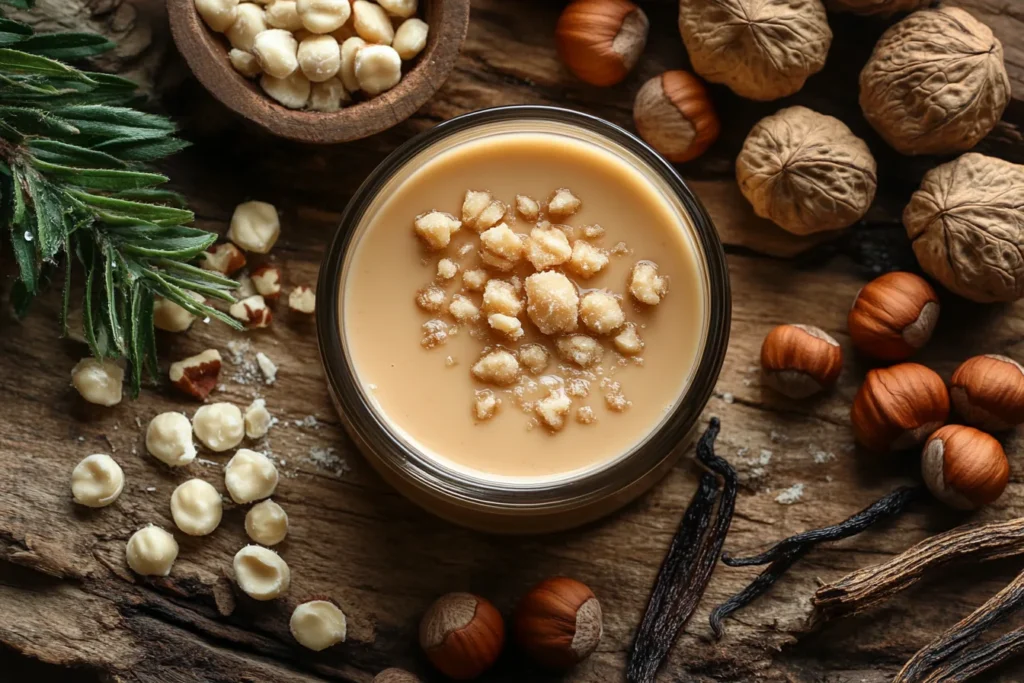Introduction to Hazelnut Creamer
Hazelnut creamer has come to be a household favored for lots coffee fans. It adds a nutty, slightly candy taste that transforms an normal cup of coffee into a satisfying treat. But have you ever stopped to ask, what components are in hazelnut creamer? While the taste would possibly experience expensive, knowledge its components famous that it’s a mixture of cautiously selected components designed to stability taste, texture, and shelf life.
If you love experimenting within the kitchen, don’t omit our Hazelnut Creamer Recipe with Sweetened Condensed Milk for a home made twist. And for dessert concept, test out our Japanese Apple Pastry Recipes perfect to pair with your favored hazelnut-flavored coffee!
This creamer comes in diverse paperwork, which include liquid, powder, dairy, and non-dairy options. Each kind has a barely one of a kind element list, however the intention stays the equal: handing over a creamy hazelnut flavor. Whether you pick your creamer refrigerated or shelf-strong, the ingredients frequently overlap, with subtle versions.
In this guide, we’ll unpack the principle components, evaluate natural and artificial versions, and talk what makes hazelnut creamer a standout preference for espresso lovers.

Table of Contents
The Key Components of Hazelnut Creamer
So, what ingredients are in hazelnut creamer? At its core, most hazelnut creamers include a combination of water, oils, sweeteners, flavoring, and emulsifiers. These ingredients ensure a smooth consistency and rich flavor that blends effortlessly into hot beverages.
Common Ingredients in Hazelnut Creamer:
Water: Found in liquid creamers, water acts as the base, providing a neutral foundation.
Vegetable Oils: These oils, like coconut or palm oil, add creaminess and mouthfeel.
Sweeteners: Often sugar, corn syrup, or artificial alternatives like sucralose provide sweetness.
Hazelnut Flavoring: Both natural extracts and artificial flavors contribute to the distinct hazelnut taste.
Emulsifiers: Ingredients like mono- and diglycerides help oil and water mix seamlessly.
Stabilizers: Carrageenan and other stabilizers maintain the creamer’s texture over time.
While powdered creamers omit water, their key components are quite similar. Non-dairy options often highlight plant-based ingredients like almond milk, oat milk, or soy derivatives, offering an alternative for those avoiding traditional dairy.
Natural vs Artificial Ingredients
Understanding what ingredients are in hazelnut creamer also involves knowing the distinction between natural and artificial components. The debate often revolves around health, taste, and environmental impact.
Natural Ingredients:
Natural hazelnut creamers emphasize ingredients derived from plants or animals without synthetic processing. Examples include:
Real Hazelnuts: Used in premium creamers for authentic flavor.
Cane Sugar: A natural sweetener without additives.
Dairy Cream: Adds a rich, traditional creaminess.
Natural Stabilizers: Such as guar gum or xanthan gum.
These ingredients tend to appeal to consumers seeking cleaner labels and a more wholesome feel to their morning coffee.
Artificial Ingredients:
Artificial components help maintain affordability, consistency, and extended shelf life. Common examples are:
Artificial Flavors: These mimic hazelnut taste without using actual nuts.
Synthetic Sweeteners: Such as sucralose or aspartame for a sugar-free option.
Preservatives: Keep the creamer fresh for months without refrigeration.
When choosing between the two, consider your dietary preferences, taste priorities, and whether sustainability matters to you. For those with nut allergies, artificial flavors can offer a hazelnut-like taste without risk.
Breakdown of Common Ingredients in Hazelnut Creamer
If you’ve ever wondered, what ingredients are in hazelnut creamer, the list often includes components that work together to deliver flavor, texture, and shelf stability. Here’s a closer look at the common ingredients found in most hazelnut creamers:
- Water
In liquid creamers, water is the base ingredient. It ensures the creamer has a smooth, pourable consistency and acts as a neutral medium for blending other components. - Vegetable Oils
Oils like coconut, palm, or soybean oil are included to mimic the creamy mouthfeel of dairy. They give hazelnut creamers their rich, satisfying texture. In non-dairy creamers, these oils play a key role in replacing animal fats. - Sweeteners
Sweeteners are vital for balancing the nutty flavor. Options range from traditional cane sugar and corn syrup to low-calorie substitutes like sucralose or stevia in sugar-free varieties. - Hazelnut Flavoring
The star ingredient! Hazelnut flavoring can be natural—extracted from real nuts—or artificial, designed to mimic the same taste without using actual hazelnuts. - Emulsifiers
Ingredients like mono- and diglycerides help water and oil mix evenly. Without emulsifiers, the creamer would separate and require constant shaking. - Stabilizers
Compounds like carrageenan or xanthan gum ensure a consistent texture, preventing the creamer from becoming too thick or watery over time. - Preservatives
For shelf-stable varieties, preservatives like potassium sorbate extend the product’s life, ensuring freshness even after weeks of storage.
A Closer Look at Additives in Hazelnut Creamer
When you ask, what ingredients are in hazelnut creamer, the role of additives often sparks curiosity. These components, while not as recognizable as water or sweeteners, play a critical role in maintaining the quality, flavor, and stability of the creamer. Let’s break them down:
- Emulsifiers
Emulsifiers ensure that oil and water mix seamlessly. Without them, you’d end up with a separated mess in your coffee. Common examples include:
Mono- and Diglycerides: These are derived from fats and keep the liquid smooth and homogeneous.
Lecithin: Often sourced from soy or sunflower, it acts as a natural emulsifier.
- Stabilizers
Stabilizers help maintain the creamer’s consistency over time. They prevent ingredients from clumping or settling. The most frequently used stabilizers are:
Carrageenan: Extracted from seaweed, this is a popular choice for its gelling properties.
Xanthan Gum: A plant-based thickener that adds viscosity without altering taste.
- Artificial Flavors
In some creamers, hazelnut flavoring is synthetic. While these artificial flavors replicate the nutty profile of real hazelnuts, they are more affordable and allergy-friendly. - Preservatives
To extend shelf life, preservatives like potassium sorbate or sodium benzoate are used. These additives inhibit the growth of mold and bacteria, ensuring the creamer stays fresh. - Colorants
Some hazelnut creamers include caramel color to give a warm, creamy hue. While not always necessary, it enhances visual appeal.

Nutritional Information for Hazelnut Creamer
Understanding what ingredients are in hazelnut creamer can help you assess its nutritional profile. Hazelnut creamer is often designed to enhance your coffee’s taste without overwhelming your calorie count, but nutritional values vary depending on whether it’s dairy, non-dairy, or sugar-free.
Here’s a typical breakdown for 1 tablespoon (15 ml) of hazelnut creamer:
- Calories
Regular creamers: 30–50 calories
Sugar-free options: 10–15 calories
Calories come primarily from fats and sugars. Sugar-free varieties cut down significantly on calorie content. - Total Fat
Regular creamers: 1–3 grams
Non-dairy creamers: 2–3 grams (from coconut or palm oils)
Fats contribute to the creamy texture but are usually kept low per serving to avoid being too heavy. - Saturated Fat
0.5–2 grams
In non-dairy creamers, saturated fats often come from coconut or palm oil. Look for labels specifying “low saturated fat” if this is a concern. - Sugars
Regular creamers: 4–6 grams
Sugar-free: 0 grams (uses artificial sweeteners like sucralose or stevia)
Most of the sweetness in traditional creamers comes from added sugar or corn syrup. - Carbohydrates
Regular creamers: 5–7 grams
Sugar-free: 1–2 grams
These are primarily from sweeteners or stabilizers like maltodextrin in powdered versions. - Protein
0 grams (in most varieties) - Additional Nutrients
Some creamers are fortified with calcium or vitamin D, especially in plant-based options.
Always check the label to align with your dietary preferences, especially if you’re managing calorie intake, sugar consumption, or allergens.
Health Considerations for Hazelnut Creamer
While hazelnut creamer adds flavor and richness to your coffee, it’s important to understand its potential health implications. Knowing what ingredients are in hazelnut creamer helps you make informed choices, especially if you’re mindful of your diet or have specific health concerns.
- Calorie and Sugar Content
Regular Creamers: These often contain added sugars, which can contribute to weight gain and spikes in blood sugar if consumed in excess. If you’re watching your calorie intake, limit portions or consider sugar-free alternatives.
Sugar-Free Creamers: Artificial sweeteners like sucralose or stevia may suit those avoiding sugar, but they aren’t universally suitable for all diets. - Fat and Cholesterol
Non-dairy options, while free of cholesterol, often contain saturated fats from oils like coconut or palm. Excessive saturated fat intake can raise LDL cholesterol levels, increasing heart health risks.
Dairy-based creamers may contain small amounts of cholesterol, but the serving size is typically too low to have a significant impact. - Allergens
Nut Allergies: Even though some creamers use artificial hazelnut flavoring, cross-contamination is possible, so check labels carefully.
Lactose Intolerance: Non-dairy creamers are a good alternative for those avoiding lactose. However, some powdered creamers may still contain trace amounts of milk proteins like casein. - Additives and Preservatives
While emulsifiers and stabilizers like carrageenan and mono- and diglycerides are considered safe in small amounts, they can cause digestive discomfort in sensitive individuals.
Artificial flavors and preservatives may also be less appealing for those prioritizing clean eating. - Daily Consumption
Using hazelnut creamer occasionally is unlikely to impact your health significantly. However, consuming multiple servings daily may lead to overconsumption of sugars, fats, or additives.
Health Tip: Consider plant-based, low-sugar, or unsweetened versions if you’re looking for a lighter or allergen-friendly option. Always read nutrition labels to ensure the creamer aligns with your dietary needs.
Making Your Own Hazelnut Creamer
If you’ve ever wondered, what ingredients are in hazelnut creamer and wanted a simpler, more natural option, making it at home is easier than you might think! A homemade version gives you complete control over the ingredients, ensuring it’s free from artificial flavors, excessive sugar, or additives. Plus, it’s incredibly satisfying to whip up something so delicious from scratch.
Ingredients You’ll Need
1 cup milk or non-dairy milk (like almond, oat, or coconut)
1 cup heavy cream or plant-based cream
3 tablespoons hazelnut syrup (store-bought or homemade)
1–2 tablespoons sweetener (maple syrup, honey, or sugar—optional)
1 teaspoon vanilla extract (for added depth of flavor)
Instructions
Combine Ingredients: In a medium saucepan, mix the milk, cream, and sweetener. Warm the mixture over low to medium heat, stirring to dissolve the sweetener completely.
Add Flavorings: Stir in the hazelnut syrup and vanilla extract. Adjust the sweetness or hazelnut flavor to taste.
Simmer and Blend: Let the mixture simmer gently for 5–7 minutes, but avoid boiling. This helps the flavors meld together.
Cool and Store: Once the creamer has cooled, pour it into a clean glass jar or bottle. Store it in the refrigerator for up to 7 days. Shake well before each use.
Tips for Customization
For a sugar-free version, use stevia or monk fruit sweetener instead of sugar.
To make your own hazelnut syrup, blend roasted hazelnuts with water and sweetener, then strain.
For a frothy touch, whisk the creamer before adding it to your coffee.
Homemade hazelnut creamer is fresh, flavorful, and free of unnecessary additives—a perfect addition to your morning routine!
How to Choose the Best Hazelnut Creamer
When faced with a variety of options, picking the best hazelnut creamer can feel overwhelming. Understanding what ingredients are in hazelnut creamer is key to making a choice that aligns with your taste preferences, dietary needs, and lifestyle. Here’s a guide to help you navigate the options:
- Check the Ingredient List
Look for creamers with real hazelnuts or natural flavors if authenticity matters to you.
Avoid products with high amounts of artificial flavors, preservatives, or excessive sugars. - Consider Your Dietary Preferences
Dairy vs. Non-Dairy: For lactose intolerance or plant-based diets, opt for almond, oat, or coconut-based creamers.
Low-Calorie or Sugar-Free Options: If you’re watching your calorie or sugar intake, sugar-free creamers made with stevia or sucralose are great alternatives. - Evaluate the Nutritional Profile
Choose creamers with low saturated fats if heart health is a concern.
Look for products with minimal sugar and additives to avoid unnecessary calories. - Test the Flavor
Some creamers have a stronger, richer hazelnut taste, while others are subtler. Experiment with different brands to find the intensity you enjoy. - Packaging and Shelf Life
If convenience is important, opt for shelf-stable creamers that don’t require refrigeration.
For freshness, refrigerated options may taste better but require storage. - Environmental and Ethical Considerations
Look for brands that prioritize sustainability, such as using eco-friendly packaging or sourcing ingredients ethically. - Budget
Higher-quality creamers made with natural ingredients may cost more, but they often deliver a better flavor and fewer additives.

Environmental Impact of Hazelnut Creamers
As more people ask what ingredients are in hazelnut creamer, another important consideration emerges: its environmental footprint. From the sourcing of ingredients to packaging and distribution, hazelnut creamers can have varying levels of impact on the planet. Here’s a breakdown of key factors to consider:
- Ingredient Sourcing
Hazelnuts: Growing hazelnuts can be relatively sustainable since they require less water compared to crops like almonds. However, large-scale farming can lead to deforestation and biodiversity loss if not managed responsibly.
Vegetable Oils: Commonly used oils like palm and coconut can contribute to deforestation and habitat destruction. Sustainable sourcing certifications (like RSPO for palm oil) are important to look for.
Artificial Ingredients: Synthetic flavors and additives have a smaller direct agricultural footprint but rely on industrial processes that may have their own environmental costs. - Production Process
The production of creamers—whether dairy or non-dairy—requires significant energy and water. Non-dairy creamers often have a lower environmental footprint, as livestock farming contributes to greenhouse gas emissions and water use. - Packaging
Single-Use Plastic Bottles: These are common for liquid creamers but contribute significantly to plastic waste.
Powdered Creamers: Often come in resealable plastic bags or cardboard containers, which may have a lower impact if properly recycled.
Eco-Friendly Packaging: Look for brands that use recyclable or biodegradable materials. - Transportation
Shelf-stable creamers that don’t require refrigeration during shipping typically have a lower carbon footprint compared to refrigerated products. - Consumer Choices
Supporting brands that prioritize sustainable farming and environmentally friendly packaging can make a difference.
Making your own hazelnut creamer at home reduces packaging waste and transportation emissions.
Frequently Asked Questions
What ingredients are in hazelnut creamer?
Hazelnut creamer typically contains water, vegetable oils, sweeteners, hazelnut flavoring (natural or artificial), emulsifiers, and stabilizers. Non-dairy options use plant-based ingredients like almond or oat milk.
Is hazelnut creamer dairy-free?
Some hazelnut creamers are dairy-free, using plant-based milks and oils instead of cream. Always check the label, as some powdered versions may still contain milk-derived proteins like casein.
Does hazelnut creamer contain real hazelnuts?
Not always. Many brands use artificial hazelnut flavoring to replicate the taste. For real hazelnuts, look for creamers labeled with “natural flavors” or check the ingredient list.
How long does hazelnut creamer last?
Unopened shelf-stable creamers can last several months, while refrigerated ones last 1–2 weeks after opening. Always follow the “best by” date and refrigerate after opening.
Conclusion
Hazelnut creamer is more than just a coffee addition it’s a mix of components that deliver warm temperature, flavor, and creaminess for your each day cup. Understanding what ingredients are in hazelnut creamer enables you are making informed selections, whether or not you’re prioritizing flavor, nutritional preferences, or environmental sustainability.
From the balance of water, oils, and sweeteners to the option of herbal or artificial hazelnut flavoring, there’s a creamer to suit every choice. You can pick among dairy and non-dairy alternatives, choose sugar-loose alternatives, or even make your personal for a more personalised contact.
As customers, we additionally have the power to don’t forget the environmental effect of our alternatives. Opting for manufacturers that emphasize sustainable practices or taking steps to lessen packaging waste via making homemade versions can make a distinction.
At the cease of the day, hazelnut creamer enhances your coffee experience whilst providing the ability to fit into plenty of lifestyles. Whether you’re savoring a store-sold favorite or a home made model, it’s all about developing a coffee moment you adore.

